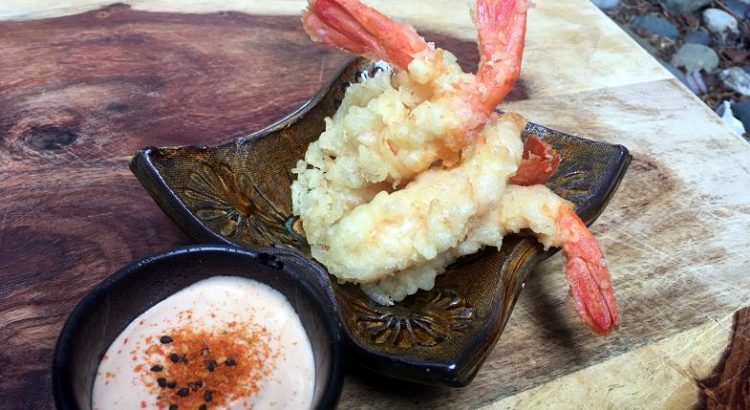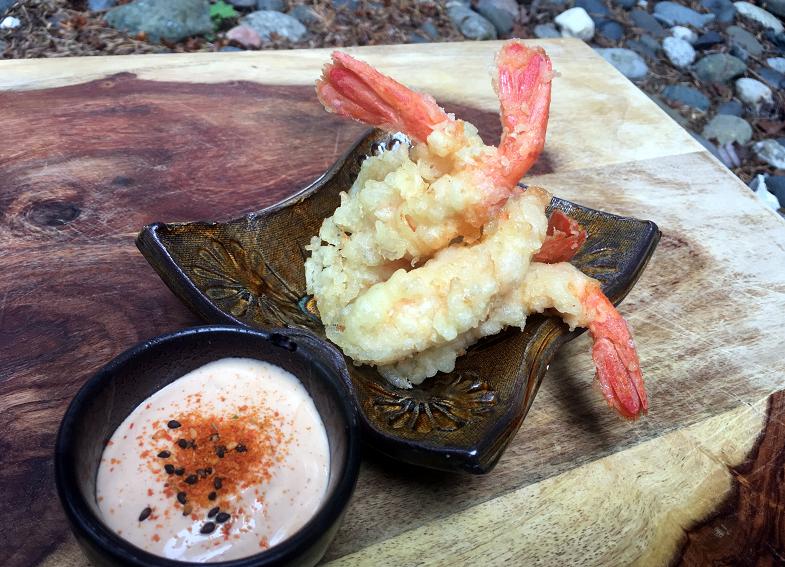 After getting completely trounced in the first round of last week’s Shellfish Festival competition, I’ve been thinking a lot about simplicity. One of my many mistakes during those surreal 45 minutes was going in too many directions at once instead of focusing on a single, well crafted dish. So yeah, fourteen years experience and I still have to go back and work on fundamentals! *laughs*
After getting completely trounced in the first round of last week’s Shellfish Festival competition, I’ve been thinking a lot about simplicity. One of my many mistakes during those surreal 45 minutes was going in too many directions at once instead of focusing on a single, well crafted dish. So yeah, fourteen years experience and I still have to go back and work on fundamentals! *laughs*
I’ve still got bags of Calvin’s freshly-caught Spot Prawns in my freezer and the whole family is home today for one reason or another. I think it’s time I channel my fryer days at Wasabiya and bang out some simple, perfect prawn tempura.
A lot of people I know (chefs included) avoid deep frying at home for two reasons: a)They think it’s messy and wasteful and b) Time flies during the cooking then grinds to a halt while your plating, leading to cold and soggy food for your guests. Both of these concerns are easily dealt with if you treat “tempura night” like the kind of big, family-centric celebrations like clam bakes or pig roasts.
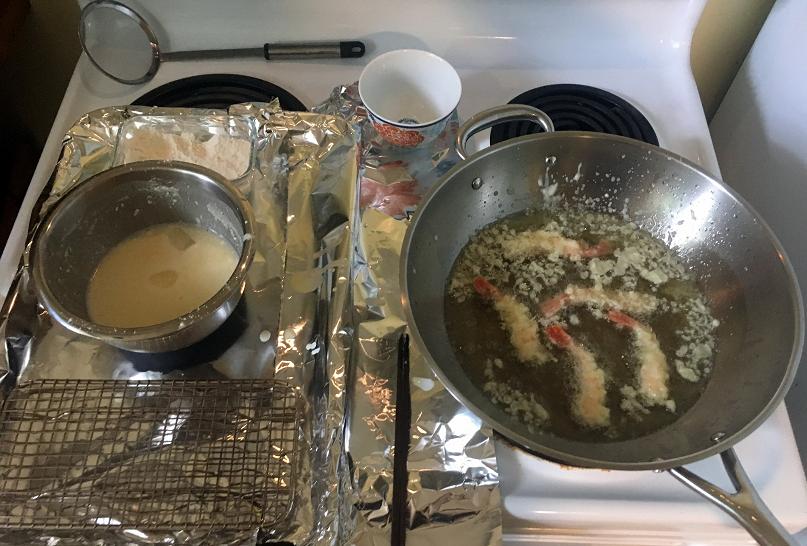 Here’s how I set up a “tempura night” event: I lay a couple large sheets of tin foil all over my stovetop to catch all the batter and splatter from the frying process and when I’m done I gather up the whole mess and dump it in the garbage, just like the newspaper/tablecloth at a clam bake. I gather everyone in the kitchen and get ‘em pitching in; mixing sauces, battering prawns or swapping out with whoever is at the stove frying. Every time a batch of prawns is done they are dumped onto a serving tray on the kitchen table surrounded by dipping sauces so they can be eaten right at the moment of peak crispiness. No prawn lasts more than a minute and the next batch is up in no time. No mess, no waiting, no problem.
Here’s how I set up a “tempura night” event: I lay a couple large sheets of tin foil all over my stovetop to catch all the batter and splatter from the frying process and when I’m done I gather up the whole mess and dump it in the garbage, just like the newspaper/tablecloth at a clam bake. I gather everyone in the kitchen and get ‘em pitching in; mixing sauces, battering prawns or swapping out with whoever is at the stove frying. Every time a batch of prawns is done they are dumped onto a serving tray on the kitchen table surrounded by dipping sauces so they can be eaten right at the moment of peak crispiness. No prawn lasts more than a minute and the next batch is up in no time. No mess, no waiting, no problem.
It seems easy to fry prawns in the Japanese style, but it really takes some careful preparation and attention to last-minute detail to make proper tempura. Improperly processed prawns, overly-thick batter, oil temperature and a million other factors conspire to turn my beautiful prawns into what chef Hiro used to curse as “some damn fish and chips”. Here are the essentials:
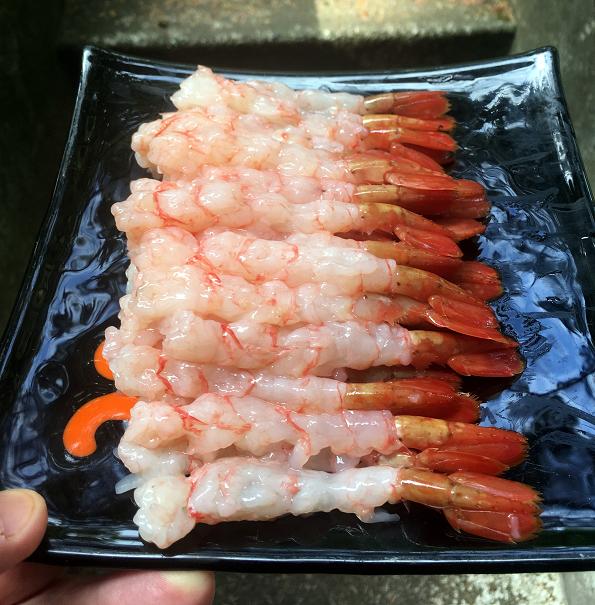 Prep: Once your prawns have been stripped of their armor a couple quick slits in their belly will keep them from curling when fried. Gently pressing and stretching the prawn makes for a better looking finished product and a quicker cooking time.
Prep: Once your prawns have been stripped of their armor a couple quick slits in their belly will keep them from curling when fried. Gently pressing and stretching the prawn makes for a better looking finished product and a quicker cooking time.
Batter: This is the trickiest bit. It shouldn’t be smooth; only a couple quick whisks to incorporate the dry flour into the liquid will do. You want to have pockets of un-mixed flour floating around on the liquid surface. It should be thick enough to coat the prawn yet thin enough to see the red stripes through it. The temperature of the liquid should be ice cold so that it will react violently (ie. create “spikey” tempura bits) when it hits the hot oil. Lastly, you should mix your batter just before frying and discard any batter that sits around on the counter for more than half an hour.
Oil Temperature: not a single bit of tempura batter or prawn should hit the oil until it has reached 350˚F. If the temperature is under the prawns will turn out greasy ‘n soggy and if the temperature is over the prawns will blacken too quickly. Don’t let either happen: Use a high-temp thermometer or drop a bit of batter in the oil when you think it’s ready. If it rises to the surface and starts to brown immediately you are ready to fry!
Time: Don’t worry about under cooked spot prawns; unlike the sad Mexican white prawns you get at the grocery store our local sea bugs are always best when lightly cooked. Get your batter golden and get them out of the oil and the “carry over cooking” will do the rest.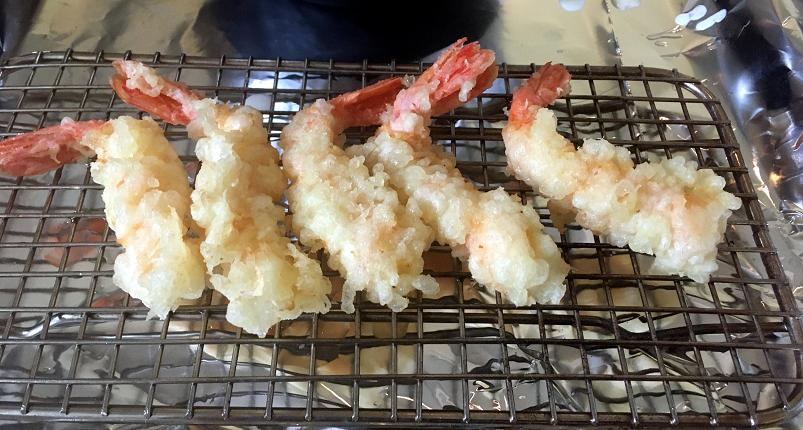
Spot Prawn Tempura (Serves 4)
Ingredients
- Vegetable Oil for Frying
- 2 cups (475ml) Ice Cold Water
- 1 Medium-Sized Egg
- 2 Cups (180g) All Purpose Flour plus more flour for dredging
- 1 lb. (approx 500g) Spot Prawns (Shells removed, tails-on, slit and squished)
Method
- Get a nice deep pot or wok filled 1/3 full with oil and heat it to 350˚F (175˚C). Once you’ve got the oil to temp turn the heat to medium and monitor it closely during the frying process. If it dips below 350˚F take a break and let the oil come back to temp.
- Gently mix together the ice water, egg and flour just enough to combine it but not enough to make it smooth. Set up your bowl with dredging flour beside your newly mixed batter right next to your frying oil and paper every inch of your stove top/work space with tinfoil.
- Take one or two prawns at a time and dredge them in flour. Dip them into your batter and carefully drop them into the hot oil. They should fizz immediately and loudly! Give each prawn a quick spritz with the batter on your fingers to create crispy little spikes all along its surface. Turn each prawn after a minute until they are golden all over. Remove the prawn from the oil with chopsticks or a slotted spoon and let them drain on a wire rack for no longer than a minute. Once you’ve got enough prawns drained just drop them on the table and let your family and friends have at ‘em!
Dipping Sauces
The more dippers you have scattered around the table, the more options and fun your crew will have, so don’t skimp on the sauce. I’d suggest two or three varieties:
- The classic dipping sauce for tempura is tensuyu: a cold, subtle mixture of dashi, soy sauce and mirin spiked with grated daikon and ginger.
- Ponzu also work well with fried prawns, especially if you’ve saved the prawn heads and are frying them alongside the tails.
- Crystal’s favourite is definitely a mixture of mayonnaise, soy sauce, vinegar and sriracha that mimics the majesty of Wasabiya’s famous Spicy Mayo.
 Music To Fry Prawns To:
Music To Fry Prawns To:
Gorillaz – The Now Now
